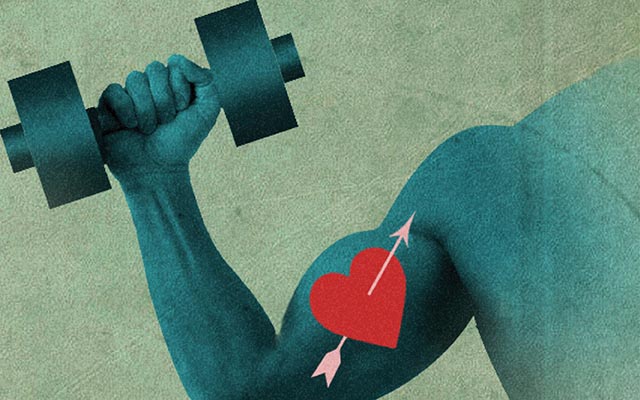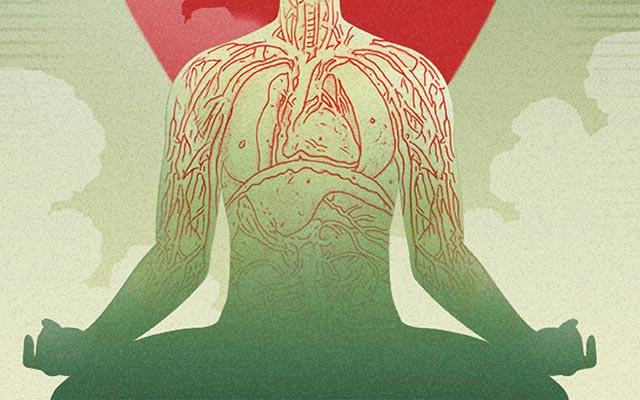Sections in this article:
Myth #1: High cholesterol is the root cause of cardiovascular disease.
Myth #2: LDL cholesterol is bad.
Myth #3: Eating cholesterol and saturated fat raises blood-cholesterol levels.
Myth #4: Statins save the lives of healthy people without heart disease.
When it comes to matters of the heart, the statistics are dire: Cardiovascular disease is the top cause of death in the United States and around the globe. Americans spend more than $300 billion annually on the costs of heart disease, stroke, and other cardiovascular diseases. And experts say the situation will only worsen as baby boomers age.
We’ve known for years that cardiovascular disease is largely preventable, yet its incidence has skyrocketed even as we have dutifully heeded the advice of leading professional organizations like the American Heart Association, cutting back on dietary fat and increasing our use of cholesterol-lowering drugs.
It’s no wonder, then, that many observers are making alarming predictions about the future of heart health. “Unless current trends are halted or reversed,” a 2004 World Health Organization report noted, “over a billion people will die from cardiovascular diseases in the first half of the 21st century.”
Among more progressive-minded health practitioners, however, it’s not all gloom and doom. Armed with a different approach to heart disease, many forward-thinking doctors are looking beyond overall cholesterol numbers to prevent — or even reverse — heart disease.
“We’re missing the big picture, which includes looking at more than someone’s total cholesterol,” says Mimi Guarneri, MD, FACC, a functional-medicine cardiologist in La Jolla, Calif., and president of the Academy of Integrative Health and Medicine. “After all, studies have shown that 80 percent of the time, people who have heart attacks have the exact same total cholesterol as people who never have a heart attack.
“So, that takes us back to what really causes cardiovascular disease — or chronic disease of the vascular system — and it’s multifactorial: It’s the food choices you make. It’s the toxins you’re exposed to. It’s the way you respond to stress and tension. It’s all of these things. But the big misnomer is, ‘Oh, it’s just my cholesterol.’”
Guarneri is not alone in her view. There are a growing number of experts taking a new approach to preventing and treating cardiovascular disease by looking at multiple contributing factors. We asked a handful of them to address the primary myths about heart health — and to explain the progressive protocols that are helping to create a new paradigm of heart care.
Myth #1: High cholesterol is the root cause of cardiovascular disease.
Since the 1950s, when a scientist named Ancel Keys cherry-picked data to support his hypothesis that saturated fat was the main driver of heart disease, we have blamed cholesterol for all our cardiovascular woes. Physicians have urged patients to adopt low-fat diets and take statins to lower cholesterol levels. But this is blaming the messenger.
“Elevated cholesterol is a symptom,” says P. Michael Stone, MD, MS, a family physician in Ashland, Ore., and a faculty member at the Institute for Functional Medicine. He believes the notion of cholesterol as cause is “the biggest misconception surrounding cardiovascular disease.”
“The big focus of the American Heart Association for the last 50 years has been cholesterol, but if it is elevated, there is a root cause for that elevation,” he says. “The answer is not as simple as a low cholesterol level.
“The best approach is to figure out what is driving abnormal or unbalanced cholesterol numbers.”
Guarneri, Stone, and others believe the future of heart-disease prevention and treatment lies not in mere symptom management — lowering cholesterol, blood pressure, and blood sugar via pharmaceuticals — but in identifying the underlying causes of those symptoms. They predict that this approach will transform the way we assess, prevent, and manage cardiovascular disease.
“Understanding the root causes can help you identify and recognize the five patterns we know impact and increase the risk of cardiometabolic syndrome: inflammation, oxidative stress, insulin dysfunction, autonomic dysfunction, and endothelial dysfunction,” says Stone.
In other words, inflammatory conditions, free radicals, high blood sugar, stress overload, and blood-clotting problems all contribute to heart disease. The problem can’t be reduced to the butter on your toast.
In many cases, dietary sources have little to do with elevated serum-cholesterol levels. Rather, the body begins to produce more of the substance on its own to handle an increased demand. For example, when chronic inflammation begins to lower testosterone production, Stone says, the body produces more cholesterol (a key precursor to testosterone) to revive the hormone.
Likewise, an autonomic nervous-system problem can also raise cholesterol production: The body produces more cortisol when it’s in fight-or-flight mode, and it requires more cholesterol to do so.
Sure, there are some people who are genetically predisposed to high cholesterol, Stone says, but they are fairly rare. Most of the time, elevated cholesterol is a response to something else occurring in the body. When we erase the symptom instead of digging for the root cause, we’re ignoring the fact that high cholesterol can also be an immune response.
“If you’re having trouble getting your LDL levels down, that might mean you have an underlying infection. So when we crash somebody’s LDL with statins, are we inhibiting their innate immune system?” Stone asks. “You look at all this and think, ‘What are we doing by willy-nilly treating a number and not looking at root cause?’”
In addition, Stone emphasizes that normal cholesterol levels do not mean no — or even, low — risk. In fact, 25 percent of people who have heart attacks have low cholesterol, he notes, while 25 percent of people with high cholesterol do not have plaque or heart disease.
“It raises the question: Is cholesterol the right marker to check — and is it the best marker to be checked?” asks Stone. “And the resounding answer is that it is a marker, but it’s not the best marker.”
Myth #2: LDL cholesterol is bad.
When rating types of cholesterol, high-density lipoproteins (HDL) are “good,” and low-density lipoproteins (LDL) are “bad” — right?
Not exactly. While many doctors swear by the standard lipid panel to measure the overall levels of HDL and LDL in the blood, many progressive-minded practitioners use advanced tests to identify the actual number and detailed characteristics of lipoprotein particles. “I expect within five years these advanced tests will be standard,” Stone says.
These tests allow practitioners to identify patients with “normal” cholesterol numbers who might still be in danger, as well as patients with high numbers who might be fine — or have things other than high cholesterol to worry about.
A typical lipid panel shows the LDL volume, not the specific number of particles. A high LDL volume may indicate that the particles are big, fluffy, and harmless.
But a low LDL volume can be misleading. It may be made up of tiny, dense particles that are vulnerable to oxidation. This increases inflammation, which in turn can trigger the cycle that leads to a heart attack.
“It’s those tiny LDL particles that have a higher risk of squeezing between the cracks of the lining of the blood vessels, causing plaque,” explains functional-medicine internist Yousef Elyaman, MD, IFMCP, founder and medical director of Absolute Health, a primary-care practice in Ocala, Fla.
“The plaque eventually gets thicker and thicker, and at some point it can pop. When it pops, the body tries to fix it, forming a clot, and that can cause a heart attack or a stroke.”
Two people might have identical LDL-cholesterol levels of 70, which is considered optimal by conventional standards. But in one person the particles could be large and harmless, while in the other the particles could be tiny and dangerous.
“So you have one person with an LDL level of 70 that’s low risk and another person with an LDL level of 70 that’s very high risk,” Elyaman says.
How can someone prevent or reverse the formation of small, dense LDL particles?
Again, it all depends on the underlying cause of oxidation, which can vary from person to person.
“I’ll have patients who say, ‘Oh, the L in LDL stands for lousy cholesterol,’” says Guarneri. “And I say, ‘No, that’s not true. It’s what happens with that cholesterol that matters — does it get oxidized? That’s when it becomes a problem for causing vascular disease.’
“So many factors can lead to oxidative stress, including air pollution; insulin resistance; exposure to toxins like lead, mercury, and cadmium; and infections like herpes, chlamydia, and hepatitis.
“No one is addressing this. Instead, most doctors tell people to eat fat-free or low-fat food,” Guarneri notes.
As for “good” HDL, which clears LDL cholesterol from your system, it is generally protective. But levels can be too high.
“Sometimes elevated HDL levels above the 80s could point to dysfunctional HDL,” says Shilpa P. Saxena, MD, a functional-medicine family physician who runs the SevaMed Institute in Lutz, Fla. “This means that the HDL particles may not be cleaning efficiently enough, and thereby are creating an increased supply of HDL particles that still don’t work.”
“It’s very tricky,” Elyaman explains. “HDL may be high due to a higher cholesterol burden, but it may also be highly elevated and protective.” In other words, a high HDL number can indicate that you have plenty of internal janitors on staff cleaning up any oxidized particles of LDL; it can also mean the HDL janitors are slacking on the job.
In order to differentiate, Guarneri uses an advanced lipid panel to measure HDL2b, the most protective, large, and buoyant form of HDL.
Knowing the precise composition and size of the HDL and LDL molecules helps doctors identify those patients with normal numbers who may still be at significant risk for cardiovascular issues.
“The case that shocks you most is the 50-year-old who has total cholesterol of 140, their HDL numbers are borderline, their LDL numbers are fine — and they have an acute myocardial infarction and a five-vessel bypass because they have severe cardiovascular disease,” Stone says.
Myth #3: Eating cholesterol and saturated fat raises blood-cholesterol levels.
For decades, we’ve been fed the diet–heart hypothesis, which suggests foods rich in cholesterol and saturated fat (think butter, eggs, full-fat yogurt, and red meat) raise our blood-cholesterol levels. But the case for low- and fat-free diets is unraveling.
In 2013 the American Heart Association and the American College of Cardiology acknowledged that there was not enough scientific evidence to support the idea that limiting dietary cholesterol lowered serum-cholesterol levels. And earlier this year, the federal government reached a similar conclusion in its 2015–2020 Dietary Guidelines for Americans, reversing 50 years of warnings about cholesterol and stating it is “not a nutrient of concern for overconsumption.”
“I love that: ‘not a nutrient of concern.’ What an unceremonious death for the tarnished reputation of dietary cholesterol!” writes Mark Hyman, MD, director of the Center for Functional Medicine at the Cleveland Clinic, in his latest book, Eat Fat, Get Thin: Why the Fat We Eat Is the Key to Sustained Weight Loss and Vibrant Health.
The government also softened its guidelines on reducing overall fat intake after it was shown that many people who adopt a low-fat diet simply replace the fat in their diets with unhealthy refined carbs and added sugars, which compensates for the missing flavor and satisfaction.
“Low-fat diets have had unintended consequences, turning people away from healthy high-fat foods and toward foods rich in added sugars, starches, and refined grains,” notes Dariush Mozaffarian, MD, cardiologist and dean of the Friedman School of Nutrition Science and Policy at Tufts University. “This has helped fuel the twin epidemics of obesity and [type 2] diabetes in America. We really need to sing it from the rooftops that the low-fat diet concept is dead. There are no health benefits to it.”
Although Hyman applauds the fact that numerous mainstream organizations are abandoning the low-fat message, he points out that many health experts still cling to two scientifically unsupported ideas about fat: first, that saturated fat causes heart disease and, second, that vegetable oils are heart healthy.
Multiple studies in recent years have shown that it’s refined carbs and sugars — not saturated fat — that tend to drive abnormal cholesterol and heart disease, largely because they contribute to insulin overload and systemic inflammation, Hyman notes. Meanwhile, saturated fats can have beneficial effects on cardiovascular health, especially when consumed in the context of a low-carb, high-fiber diet rich in omega-3 fatty acids.
“Dietary saturated fat raises the good kind of LDL (light, fluffy LDL) and raises HDL (the ‘good’ cholesterol),” he explains.
Some experts think polyunsaturated vegetable oils are a heart-healthy alternative to saturated fats. But Hyman warns against consuming these highly refined and processed oils (think corn, sunflower, and safflower oils) because they are high in pro-inflammatory omega-6 fatty acids. Their components quickly become rancid, which can lead to oxidized cholesterol in the body. And oxidation is the primary driver of small, dense, dangerous LDL.
His advice on where to find truly heart-healthy fats? Get polyunsaturated and monounsaturated fats from whole foods such as fish, nuts, seeds, and avocados. And don’t fear the saturated fats in butter, meat, chicken, and eggs.
Myth #4: Statins save the lives of healthy people without heart disease.
Statins are among the most widely prescribed drugs in the United States, and the number of Americans taking them swelled after the American Heart Association and the American College of Cardiology issued new guidelines in 2013 that expanded the parameters of who qualified for treatment. The controversial advice elicited protest from many corners of the medical world.
“I think if we go with the American Heart Association’s current guidelines, we are absolutely missing the mark,” Guarneri says. “The guidelines would place 87 percent of men and 54 percent of women between the ages of 60 and 75 on statin therapy. Talk about a multibillion-dollar business.”
Rita Redberg, MD, a cardiologist at the University of California, San Francisco Medical Center and the editor of JAMA Internal Medicine, wrote a pointed critique in the New York Times, arguing that the shift in guidelines was not based on data showing the benefits of lowering cholesterol and would primarily benefit Big Pharma.
And what the drug companies don’t advertise, adds Guarneri, is that otherwise-healthy people on statins continue to have heart attacks. “People have lost sight of the big picture because cholesterol is an easy target: ‘You just take a pill; we lower your cholesterol,’” she says.
And then there are the side effects. Several studies have linked long-term use of statins to increased risk of diabetes, cancer, and even cognitive impairment.
“Statins are overused and overpromised in primary prevention,” Redberg says, adding that lifestyle changes such as giving up smoking, adopting a healthy diet, and exercising are much better at reducing the risk of heart disease. “People should understand the risks and limited benefit in an informed discussion before deciding if statins are right for them.”
There are cases in which statins are warranted, Elyaman says. “If someone already has heart disease, then we know that individual has gotten to the point where she is high risk — that plaque that’s formed can pop at any second. If she’s not willing to make any lifestyle changes, then statins may be in order,” he explains.
“But I think we have to get the message out to all of those people on statins who don’t have heart disease that they don’t need to be taking them.”
Another way statins can backfire: Once people are on the medication, they often feel less of an urgency to make lifestyle changes, says Elizabeth Frates, MD, a physician and health-and-wellness coach in the Boston area with expertise in lifestyle medicine.
They mistakenly believe that the drug “allows them to eat processed foods or eat unhealthy foods. They feel that their medicine gives them the superpower where they don’t have to worry about their lifestyle anymore,” she explains.
Meanwhile, doctors also underestimate their patients, says Elyaman. “There’s this misconception among many doctors that patients aren’t willing to make lifestyle changes. Well, if you don’t believe that your patients are going to make lifestyle changes, it can become a self-fulfilling prophecy.
“I’ve actually heard physicians tell their patients, ‘You know, you should probably eat a healthy diet and exercise, but you’re probably not going to do that. I know I’m not going to do that. So go ahead and take this pill.’”
Donald Hensrud, MD, who directs the Mayo Clinic Healthy Living Program in Rochester, Minn., thinks that lifestyle changes in diet and nutrition, exercise, and resiliency can make the difference when it comes to cardiovascular disease. “With lifestyle, people underestimate just how powerful it can be,” he says.
Saxena agrees. Doctors should trade their “to statin or not to statin” focus for an approach that goes beyond mere cholesterol numbers to identify and address the root causes of cardiovascular disease.
“We need to make a big U-turn in the way we live,” she says.
8 Ways to Prevent Heart Disease
Cardiovascular disease is preventable for most people, says functional-medicine physician Shilpa P. Saxena, MD. “A lot of people think, ‘Oh, it runs in my family so I am doomed to it,’” she says. “But terrible lifestyle choices can also run in families.”
The root causes of heart disease will vary from person to person. Recent studies have linked stress, environmental pollutants, and even the state of your microbiome to increased cardiovascular risk. But everyone can benefit from making positive adjustments to their nutrition, fitness, stress-management practices, and sleep habits.
The key, says Saxena, is modifying and leveraging lifestyle changes so that we don’t have to rely solely on medications and procedures.
These tips from our experts on the best lifestyle changes can help you take a proactive approach to preventing — or even reversing — heart disease.
1. Eat more whole foods.

Adopting a “food first” mentality is key to preventing heart disease, says cardiologist Mimi Guarneri, MD, FACC, president of the Academy of Integrative Health and Medicine. Make the switch to higher-quality whole foods and anti-inflammatory spices. And stay away from processed foods that can drive up blood sugar.
Guarneri recommends a Mediterranean-style diet but notes that there are other protein-rich, plant-centered ways of eating; she says the key is in knowing what to avoid. “We know trans fats are bad. We know simple carbs are bad. We know refined sugar is bad,” she says.
Yousef Elyaman, MD, IFMCP, recommends starting off simply: Eat half a handful of nuts every day, two servings a week of fish that are high in omega-3 fatty acids but low in mercury (like wild-caught salmon), and six servings of colorful vegetables and two servings of fruit a day.
2. Get off the low-fat bandwagon.

Low-fat diets generally replace fat with sugar and refined carbs to compensate for lack of taste, which can lead to problems with insulin regulation, notes Saxena. Embracing healthy fats helps stabilize blood sugar and appetite. Mark Hyman, MD, director of the Center for Functional Medicine at the Cleveland Clinic, adds that long-maligned saturated fats like coconut oil can actually lower inflammation.
Still, it’s critical to eat plenty of vegetables and avoid refined carbohydrates, because “saturated fats cause inflammation only in the context of two things: low levels of omega-3 fats and high levels of carbohydrates,” Hyman writes in Eat Fat, Get Thin. While Elyaman agrees that healthy fats can be beneficial, he adds that there are some people who have the APOE4 gene, known as the Alzheimer’s gene, who may do worse on a high-fat diet. “It’s not one-size-fits-all,” he says.
3. Time your meals.

Once you’ve improved the quality and quantity of your diet, says Saxena, aim for optimal timing: “Avoid late-night eating and consider intermittent fasting.” Many experts agree that eating your biggest meal at midday is best, as is adhering to an “eat light after dark” policy whenever possible.
4. Rightsize meals and portions.

Saxena says it’s important not to overeat. Focus on filling up on vegetables; use smaller plates so you’re not tempted by an abundance of food.
5. Go beyond cardio.

Cardio exercise has the best reputation when it comes to heart health, but most experts agree it’s not enough by itself. Saxena recommends strength training to build muscle. “By optimizing your muscle mass, you can increase longevity, fight illness, and prevent injuries — all of which are equally important for total body health, inside and out,” she says.
Elyaman agrees that there are benefits to both cardio and strength training, and adds that, from a cardiovascular point of view, “you get more bang for your buck with high-intensity interval training. It helps clear out old mitochondria and stimulate new mitochondria.” (For more on interval training, go to “Steady-State Cardio Vs. High-Intensity Interval Training.”)
6. Quit smoking.

Smoking raises triglycerides in the blood, increases platelet “stickiness,” and leads to thickened and narrowed blood vessels — all risk factors for heart disease. If you smoke, quitting is one of the most direct ways to improve your heart health.
7. Manage your stress.

Saxena recommends techniques like mindfulness, meditation, prayer, and deep breathing to increase the “cool, calm, connected healing state of the body.” This is critical for heart health, she says, because the autonomic nervous system, which controls our stress response, “is strongly connected to optimal function of the cardiovascular and metabolic systems of your body.”
Our fight-or-flight stress hormones are important in helping us manage acute situations, Guarneri explains, but they backfire over the long term. “If you got hit by a car tomorrow and you were bleeding in the street, you would want those hormones because they would say, ‘We’re bleeding. Raise the heart rate, raise the blood pressure, raise the aldosterone to conserve salt and water.’” But, she adds, when these stress hormones are flowing constantly, “the platelets get stickier. The coronaries constrict. The blood pressure goes up. The heart rate goes up. The heart-rate variability goes down.” These factors all put heart health at risk. (For more on managing daily stress, see “The Cortisol Curve.”)
8. Nurture positive connections.

Relationships with family, friends, and others can go a long way toward improving — or undermining — overall health. A study presented in 2014 at the American College of Cardiology symposium identified that being in a happy marriage predicts lower risk of cardiovascular disease; another 2014 study in the Journal of Health and Social Behavior conversely found that being in an unhappy marriage leads to higher risks to heart health.
Testing for Cardiovascular Risk Factors
Getting the right tests is a big part of preventing, assessing, managing, and even reversing cardiovascular disease. Conventional medical wisdom tends to look at traditional metrics like cholesterol and blood-pressure levels, age, gender, family history, and whether or not you’re a smoker.
Progressive-minded docs look at those variables as well, but they dig deep for other cardiovascular risk factors, including inflammation, imbalances in blood sugar and insulin, and oxidative stress, which affect things like cholesterol and blood pressure.
Looking to measure your overall cardiovascular disease (CVD) risk? Here are some tests to consider in partnership with your healthcare provider.
- Advanced Lipid Tests: Unlike the standard lipid panel, advanced tests like the NMR Lipid Profile or the Cardio IQ Lipoprotein Fractionation look at the all-important particle size of LDL and HDL. “You should have less than 1,000 total LDL particles and no more than 400 small particles (although ideally you shouldn’t have any!),” notes Mark Hyman, MD, director of the Center for Functional Medicine at the Cleveland Clinic, in his new book, Eat Fat, Get Thin: Why the Fat We Eat Is the Key to Sustained Weight Loss and Vibrant Health.
- High-Sensitivity C-Reactive Protein Test: This marker of inflammation is a big clue to your overall CVD risk. “When your inflammation is high for whatever reason — maybe it’s certain foods you eat, or gut dysbiosis, or the presence of pro-inflammatory visceral fat — it can cause the walls of our blood vessels to become leaky and inflamed as well, which makes it a lot easier for the tiny, dense LDL cholesterol particles to squeeze through the cracks and trigger the cycle of plaque buildup,” says functional-medicine internist Yousef Elyaman, MD, IFMCP, the founder and medical director of Absolute Health, a primary-care practice in Ocala, Fla.
- Glucose and Insulin-Tolerance Test: Insulin resistance can cause elevated lipids and is associated with an increased risk of cardiovascular disease. “Your fasting sugar should be between 70 and 80 mg/dl and your one- and two-hour sugars should be less than 120 mg/dl,” Hyman notes.
- Hemoglobin A1c Test: In order to identify CVD risks early, notes Hyman, it’s a good idea to do this test, which measures average blood sugar over the previous six weeks, as well as the above glucose- and insulin-tolerance testing. “Anything over 5.5 percent is high,” he notes.
- Homocysteine, 25-Hydroxy Vitamin D, Vitamin B12 Tests: These tests measure levels of key heart-protective nutrients. “Your homocysteine measures your folate status and should be between 6 and 8 micromoles per liter,” Hyman states.
- Oxidized LDL Test: This test measures the amount of oxidized LDL in the blood. When small, dense LDL particles become oxidized or rancid, they can trigger the process that leads to heart disease.
- Lp-PLA2 Test: Both Elyaman and integrative cardiologist Mimi Guarneri, MD, FACC, a functional-medicine cardiologist in La Jolla, Calif., recommend this test, which measures an enzyme that contributes to inflammation and atherosclerosis.
- Carotid Intima-Media Thickness (CIMT) Test: This high-resolution ultrasound test identifies plaque in the arteries in your neck, which is associated with cardiovascular-disease risk. “We want to know how inflamed your major vessels are and how much plaque you are creating, so we look at your carotid arteries, which highly correlate with what’s happening in the heart vessels,” says P. Michael Stone, MD, MS, a family physician who practices functional medicine in Ashland, Ore., and a faculty member at the Institute for Functional Medicine.
If I Ran the American Heart Association…
In an ideal word, how should the American Heart Association (AHA) tweak the way it assesses and manages cardiovascular disease? We asked some of our experts for their opinions. Here’s what they said.
“If the AHA had more comprehensive guidelines on how to use lifestyle as medicine, patients would benefit greatly. Providers should be guided to assess someone’s specific cardiac and metabolic risks, prescribe a personalized diet/exercise/stress/sleep/smoking cessation plan of care (based on their specific risk factors, etc.), and implement therapeutic lifestyle change (TLC) with proven behavior modification strategies. Much of chronic disease, including heart disease, would be reduced and/or prevented.”
— Shilpa P. Saxena, MD, a family physician who runs the SevaMed Institute in Lutz, Fla.
“I would love to see the AHA advocate for the concept of healthy communities — sidewalks that we can walk on, neighborhoods that we don’t have to worry we’re going to get mugged in, healthy farmers’ markets, encouragement of people coming together, walking programs, cooking programs. This is not going to happen one-on-one in the physician’s office.”
— Mimi Guarneri, MD, FACC, a functional-medicine cardiologist in La Jolla, Calif., and president of the Academy of Integrative Health & Medicine
“[The AHA should recommend that] anybody with a family history of stroke and early heart attack, no matter what your lipids are, you should have them subfractionated to see what is driving your lipids.”
— P. Michael Stone, MD, MS, a family physician who practices functional medicine in Ashland, Ore., and a faculty member at the Institute for Functional Medicine
“They need to advocate for a change in the way we reimburse doctors. Physicians practice what they get paid to do. So, the real issue is changing reimbursement so that practitioners get paid to counsel patients on how to lead healthy lifestyles. I think with these changes, traditional physicians and healthcare practitioners will stop relying on medications for these chronic conditions — cardiac disease, diabetes, obesity — and they will start feeling confident in their ability to empower patients to adopt healthy habits.”
— Elizabeth Frates, MD, a Boston-area physical medicine and rehabilitation physiatrist and health-and-wellness coach with expertise in lifestyle medicine
“If you look at the current guidelines, they only give you a six-month window of dietary and lifestyle changes. What I wish the AHA would recommend is to really, really dig into that six-month window and put a real focus on sustainable modifiable lifestyle changes instead of just basically saying, “Tell them to eat healthy and exercise, and when that fails, put them on a statin.”
— Internist Yousef Elyaman, MD, IFMCP, the founder and medical director of Absolute Health a primary-care practice in Ocala, Fla.





This Post Has 2 Comments
This article substantiates information I have lived by for decades. I have been considering food as the best medicine, regular exercise and meditation for stress reduction since I was a young adult. I’m in my 70s now and listen to my friends follow the advice of the AHA and their doctors as they blame their high cholesterol, jump on the statins, avoid fat and salt and feel they’re doing the best thing for themselves. I have been considered lunatic fringe for decades and now the research is supporting what alternative medicine has been saying all along. My friends will continue to follow the doctor’s orders, I’m sure. Thank you for this article. Perhaps it will reach many people in the mainstream.
Twenty-five percent of the population has a genetic condition called “lipoprotein (a)” which is a second source of cholesterol production. People with this condition have elevated lipids. Neither diet, nor exercise, nor statin use can correct the condition. Testing for lipoprotein (a) should have been included in your article about CVD.